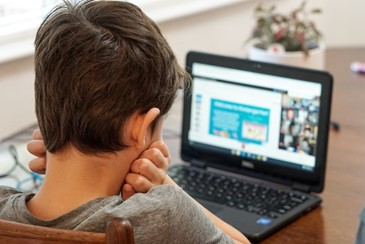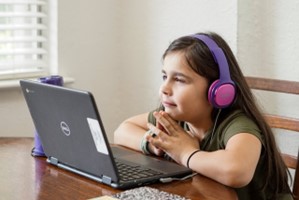
David Krakoff works as a school principal who is passionate about equity in schools, differentiated instruction, professional learning communities, restorative justice, and school improvement. In the following article, Principal David Krakoff discusses the benefits and disadvantages of remote classrooms.
After the advent of the COVID-19 worldwide pandemic, everyone certainly learned just how possible online learning was, as well as some of the challenges that came with that education model as a replacement for a classroom environment.
Online learning can be a great asset for elementary students when it comes to flexibility, time management, and the minimization of social stressors like bullying. However, some of the downsides to learning online can be unhealthy screen light exposure, a lack of emotional support, and poor socialization.
In this article, Principal David Krakoff provides a complete overview of online learning, specifically for elementary students. By the conclusion, it will be clear that online learning may have some advantages for elementary students, but also comes with risks.
Evaluating the Pros and Cons
Although there is plenty of novelty and convenience to be commented on when it comes to online learning, as the world learned during the COVID-19 pandemic, this does not mean this is a perfect education model. When it comes to elementary student experiences, the disadvantages as well as the benefits must be considered.
With that in mind, Principal David Krakoff has prepared a list of both aspects below:
Pros to Online Learning:
- Comforts of Home
- Time Management Flexibility
- Less Social Stress
Cons to Online Learning:
- Unhealthy Exposure to Screen Light
- Less Emotional Support Available
- Less Opportunity For Socialization
Principal David Krakoff takes a closer look at each of these pros and cons below to gain a more accurate understanding of why online learning online learning in elementary school still has significant room for improvement in terms of development. While some schools and educators have successfully implemented online learning for younger students, there are still many challenges to overcome.
Positive Aspects of Online Learning:
Comforts of Home
Principal David Krakoff reports that some
children thrive best when they are allowed to remain in their comfortable, home environment, according to education and behavior experts. Rather than experiencing the often stressful and even distracting experience of getting ready for school, traveling to a classroom, and being stimulated by multiple classmates, a student can focus more firmly on their task.
This is usually thanks to the consistency of a home environment, though some training may be required to get used to the change.
Time Management and Flexibility
When a student is not required to sit in a classroom setting at a specific time each day and focus on either a teacher’s instruction or specific assignments, they are naturally given more freedom. An online setting sometimes allows a student to plan their own learning time and breaks throughout the day, and even multi-task.
Less Social Stress
David Krakoff says that although it is not pleasant to consider, bullying and social anxiety are issues that plague even the youngest in our society. Without having to worry about a particularly antagonistic classmate a few desks over, or deal with the distraction of sitting in a large group of people, socially anxious students can hone their focus on their homework and learning.
 Negative Aspects of Online Learning
Negative Aspects of Online Learning
Unhealthy Exposure to Screen Light
David Krakoff explains that all electronic devices emit a specific type of light called “blue light.” Unfortunately, though it is necessary for most types of screens, online learning can cause overexposure to this light and negatively impact an elementary student’s focus in the long run. To make matters worse or compound the same focus issue, blue light has also been linked to problems with sleeping.
Less Emotional Support Available
David Krakoff says that depending on the student, the lack of a familiar teacher can sometimes lead to less emotional support than the student is used to while learning online instead of in a classroom setting.
Parents need to be heavily involved in the process, taking on the teacher’s role, and may have trouble adjusting to the child’s need for emotional support throughout the day.
Less Opportunity for Socialization
Finally, a student who switches to online learning, even as early in their education as elementary grades, will undoubtedly feel a lower amount of socialization when compared to being physically present around peers in a classroom.
Students who are used to interacting with both their peers and adults every day on a strict schedule may find the limitations of a screen confining. Instead, David Krakoff says that online students will need to find ways to socialize outside of their virtual classroom in extracurricular activities, such as dance lessons or a team sport.
In Conclusion
David Krakoff explains that online learning can provide numerous benefits, such as increased flexibility and accessibility, as well as the ability to learn at one's own pace in a comfortable home setting.
However, it also poses significant challenges, including the lack of face-to-face interaction, the potential for distractions, and the need for self-discipline and motivation. Ultimately, the effectiveness of online learning depends on a variety of factors, including the student's learning style, attentiveness, and the level of support and engagement from teachers and parents.
As technology continues to evolve, it is essential to continue exploring innovative ways to enhance online learning and ensure that it remains a viable option for students of all backgrounds and ages.
 David Krakoff works as a school principal who is passionate about equity in schools, differentiated instruction, professional learning communities, restorative justice, and school improvement. In the following article, Principal David Krakoff discusses the benefits and disadvantages of remote classrooms.
After the advent of the COVID-19 worldwide pandemic, everyone certainly learned just how possible online learning was, as well as some of the challenges that came with that education model as a replacement for a classroom environment.
Online learning can be a great asset for elementary students when it comes to flexibility, time management, and the minimization of social stressors like bullying. However, some of the downsides to learning online can be unhealthy screen light exposure, a lack of emotional support, and poor socialization.
In this article, Principal David Krakoff provides a complete overview of online learning, specifically for elementary students. By the conclusion, it will be clear that online learning may have some advantages for elementary students, but also comes with risks.
David Krakoff works as a school principal who is passionate about equity in schools, differentiated instruction, professional learning communities, restorative justice, and school improvement. In the following article, Principal David Krakoff discusses the benefits and disadvantages of remote classrooms.
After the advent of the COVID-19 worldwide pandemic, everyone certainly learned just how possible online learning was, as well as some of the challenges that came with that education model as a replacement for a classroom environment.
Online learning can be a great asset for elementary students when it comes to flexibility, time management, and the minimization of social stressors like bullying. However, some of the downsides to learning online can be unhealthy screen light exposure, a lack of emotional support, and poor socialization.
In this article, Principal David Krakoff provides a complete overview of online learning, specifically for elementary students. By the conclusion, it will be clear that online learning may have some advantages for elementary students, but also comes with risks.
 Negative Aspects of Online Learning
Negative Aspects of Online Learning